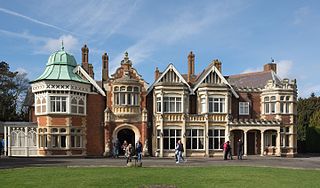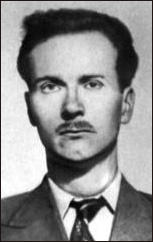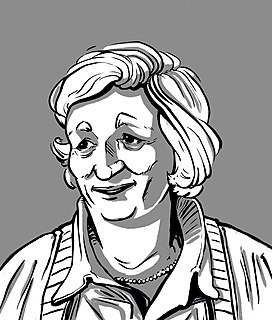
Bletchley Park is an English country house and estate in Bletchley, Milton Keynes (Buckinghamshire) that became the principal centre of Allied code-breaking during the Second World War. The mansion was constructed during the years following 1883 for the financier and politician Sir Herbert Leon in the Victorian Gothic, Tudor, and Dutch Baroque styles, on the site of older buildings of the same name.
Bata Corporation is a Czech multinational footwear and fashion accessory manufacturer and retailer, founded in the town of Zlín, today in the Czech Republic. After World War II, its factories in socialist states were nationalized, while its branches in capitalist states remained family-owned. It is now based in Lausanne, Switzerland. The principal subsidiaries are Bata Europe, Bata North America, Bata Asia-Pacific-Africa and Bata Latin America.

John Cairncross was a British civil servant who became an intelligence officer and spy during the Second World War. As a Soviet double agent, he passed to the Soviet Union the raw Tunny decryptions that influenced the Battle of Kursk. He was alleged to be the fifth member of the Cambridge Five. He was also notable as a translator, literary scholar and writer of non-fiction.
Sun Media Corporation was the owner of several tabloid and broadsheet newspapers in Canada and the 49 percent owner of the now defunct Sun News Network. It was a subsidiary of Quebecor Media.
Alfred Dillwyn "Dilly" Knox, CMG was a British classics scholar and papyrologist at King's College, Cambridge and a codebreaker. As a member of the Room 40 codebreaking unit he helped decrypt the Zimmermann Telegram which brought the USA into the First World War. He then joined the Government Code and Cypher School (GC&CS).

The Bata Shoe Museum (BSM) is a museum of footwear and calceology in Toronto, Ontario, Canada. The museum's building is situated near the northwest of the University of Toronto's St. George campus, in downtown Toronto. The 3,665-square-metre (39,450 sq ft) museum building was designed by Moriyama & Teshima Architects, with Raymond Moriyama as the lead architect.

Enigma is a 2001 espionage thriller film directed by Michael Apted from a screenplay by Tom Stoppard. The script was adapted from the 1995 novel Enigma by Robert Harris, about the Enigma codebreakers of Bletchley Park in the Second World War.

Cathleen Synge Morawetz was a Canadian mathematician who spent much of her career in the United States. Morawetz's research was mainly in the study of the partial differential equations governing fluid flow, particularly those of mixed type occurring in transonic flow. She was professor emerita at the Courant Institute of Mathematical Sciences at the New York University, where she had also served as director from 1984 to 1988. She was awarded the National Medal of Science in 1998.

Tomáš Jan Baťa,, also known as Thomas Bata Jr. and Tomáš Baťa ml., was a Czech-born Canadian businessman and philanthropist. He ran the Bata Shoe Company from the 1940s until the 1980s.

Shaun Wylie was a British mathematician and World War II codebreaker.
In 1941 when the Axis invaded Yugoslavia, King Peter II formed a Government in exile in London, and in January 1942 the royalist Draža Mihailović became the Minister of War with British backing. But by June or July 1943, British Prime Minister Winston Churchill had decided to withdraw support from Mihailović and the Chetniks he led, and support the Partisans headed by Josip Broz Tito, even though this would result in "complete communist control of Serbia". The main reason for the change was not the reports by Fitzroy Maclean or William Deakin, or as later alleged the influence of James Klugmann in Special Operations Executive (SOE) headquarters in Cairo or even Randolph Churchill, but the evidence of Ultra decrypts from the Government Code and Cipher School in Bletchley Park that Tito's Partisans were a "much more effective and reliable ally in the war against Germany". Nor was it due to claims that the Chetniks were collaborating with the enemy, though there was some evidence from decrypts of collaboration with Italian and sometimes German forces.
Amy Elizabeth "Betty" Thorpe was, according to William Stephenson of British Security Coordination, an American spy, codenamed "Cynthia", who worked for his agency during World War II. British Security Coordination was a cover organization that had been set up in New York City by the British Secret Intelligence Service (MI6) in May 1940.
Mavis Lilian Batey, MBE, was an English code-breaker during World War II. She was one of the leading female codebreakers at Bletchley Park.
Mair Russell-Jones, born Mair Eluned Thomas, was a graduate in Music and German from Cardiff University who during the Second World War worked as a civilian codebreaker for the Government Code and Cypher School at Bletchley Park. She worked in Hut 6, decrypting messages in Enigma machine cipher.
Sonja I. Bata was a Swiss Canadian businesswoman, philanthropist, collector and museum founder, who trained as an architect.
Rozanne Felicity Hastings Colchester worked in British intelligence in the 1940s.
Ann Katharine Mitchell was a British cryptanalyst and psychologist who worked on decrypting messages encoded in the German Enigma cypher at Bletchley Park during the Second World War. After the war she became a marriage guidance counsellor, then studied for a Master of Philosophy at the University of Edinburgh. She worked at the university's Department of Social Administration and wrote several academic books about the psychological effects of divorce on children, including Someone to Turn to: Experiences of Help Before Divorce (1981) and Children in the Middle: Living Through Divorce (1985).
About 8,000 women worked in Bletchley Park, the central site for British cryptanalysts during World War II. Women constituted roughly 75% of the workforce there. While women were overwhelmingly under-represented in high-level work, such as cryptanalysis, they were employed in large numbers in other important work, such as operating cryptographic machinery and communications machinery; translating of Axis documents; traffic analysis; clerical duties, and many more besides. Women made up the majority of Bletchley Park’s workforce, most enlisted in the Women’s Royal Naval Service, WRNS, nicknamed the Wrens.

Herbert Morawetz was a Czechoslovakian-American chemical engineer. He was a professor of chemistry at NYU. His work focused on polymer chemistry and macromolecules.








